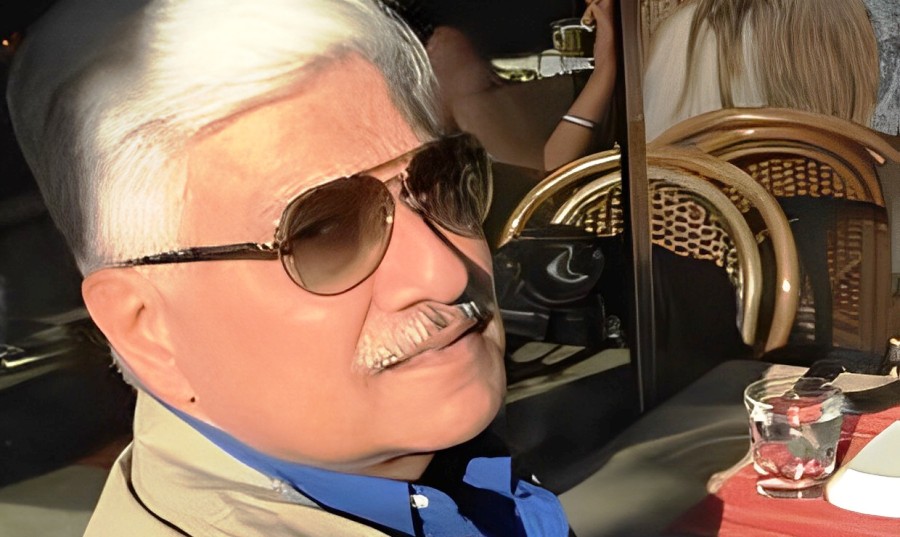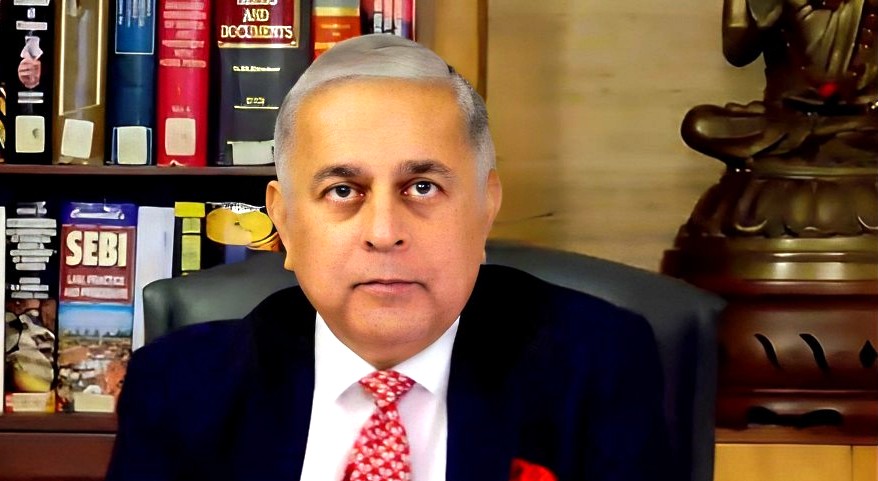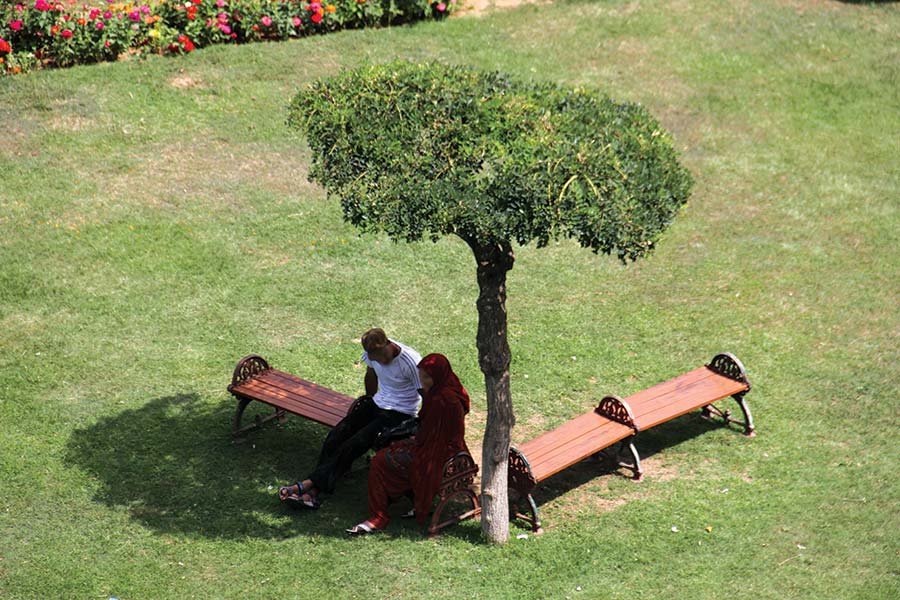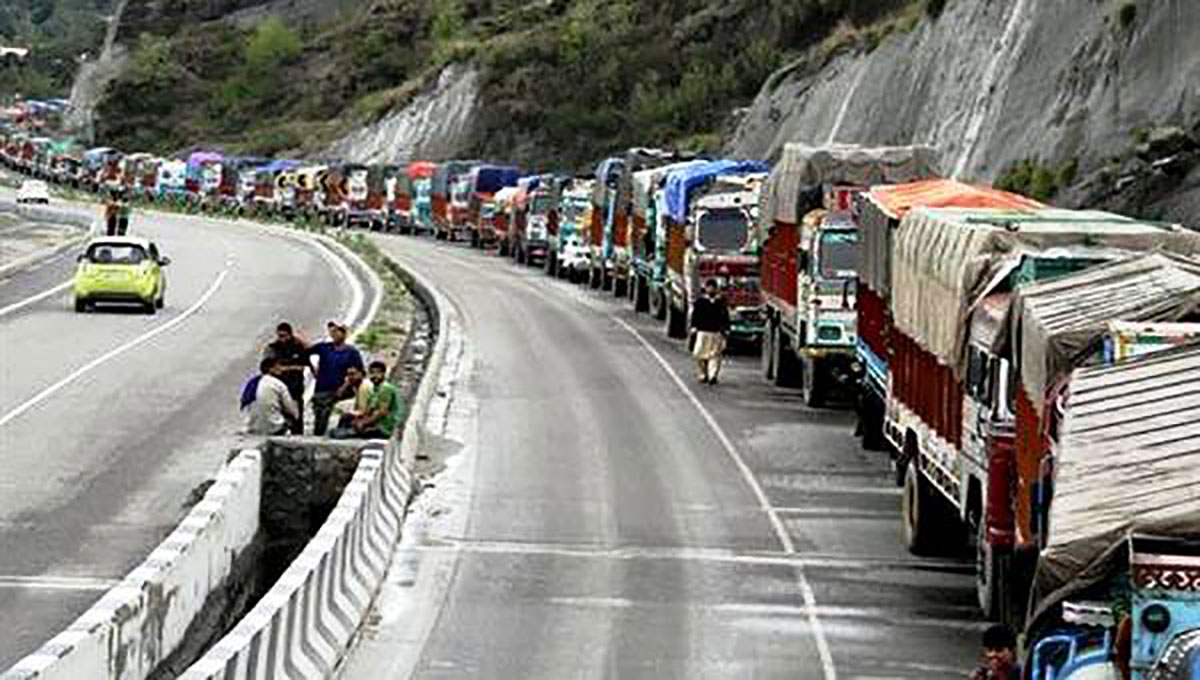On Day 8 of the hearing in a batch of petitions challenging the August 5, 2019 decision to put an end to the autonomy guaranteed to Jammu and Kashmir (J&K) under Article 370 of the Constitution, advocate Dinesh Dwivedi challenged the grounds on which Article 370 is claimed to have attained a ‘permanent character’, reports Gursimran Kaur Bakshi

TODAY, on Day 8 of the hearings In Re Article 370, senior advocate Dinesh Dwivedi began by apologising for a “serious error” in referring to the “merger” of Jammu & Kashmir (J&K) in his written submissions.
“Milords, wherever I have referred to the merger of Kashmir, please read ‘merger’ as ‘accession’ as Kashmir did not merge (with India),” Dwivedi, who is representing petitioners advocate Manohar Lal Sharma and journalist Prem Shanker Jha, clarified.
A five-judge Constitution Bench of the Supreme Court continued hearing a batch of petitions challenging the August 5, 2019 decision to end the autonomy guaranteed to J&K under Article 370 of the Indian Constitution.
A brief recap
The debate on whether the signing of the Instrument of Accession by the last Dogra king of J&K, Maharaja Hari Singh, could be considered “integration” of J&K began with submissions of advocate Zafar Shah.
The Instrument of Accession was a declaration made by the erstwhile ruler of the then-independent Princely State of J&K and the then Governor General of India, Lord Louis Mountbatten, to conditionally accede to the dominion of India as explained by The Leaflet here.
Shah, who is representing the Bar Council of J&K, was the first to argue that even though J&K “unconditionally acceded” to India, J&K did not completely “integrate” with India as no “merger agreement” was executed between the two sovereign States.
Shah made this argument in the context that since no merger was signed, the maharaja retained residuary powers of legislation. These powers were then subsumed into Article 370.
However, the Bench headed by Chief Justice of India Dr DY Chandrachud and comprising Justices SK Kaul, Sanjiv Khanna, BR Gavai and Surya Kant clarified that integration of J&K with India was complete and final.
Justice Khanna remarked: “I have a reservation on the use of the word complete integration. [In the context that complete integration had not taken place.] Complete integration of [J&K with India] has taken place in terms of Article 1 of the Indian Constitution.”
Even the CJI intervened and said: “There was no conditional surrender of sovereignty. The surrender of sovereignty was absolutely complete”.
Senior advocate Rajeev Dhavan, who is representing the Jammu and Kashmir People’s Conference, reworked the argument during his submission.
“Through the signing of the Instrument of Accession, external sovereignty is lost, but internal sovereignty is not lost,” he contended.
According to advocate Dushyant Dave, who is representing petitioner advocate Rifat Ara Butt, the Instrument of Accession has been virtually transposed into Article 370. Therefore, any interpretation of Article 370 must be done in light of Article 370 itself.
All States acceded to India with unqualified sovereignty
Dwivedi began his arguments by stating that J&K’s accession is different from other Princely States because it acceded after August 15, 1947. The rest of the Princely States had concluded their standstill agreements and accessions before August 1947 because a standstill agreement was a precondition for an instrument of accession.
According to him, J&K was different because as per the Memorandum of the Cabinet Mission and the India Independence Act, 1947, it had become an independent country in August 1947 after British paramountcy had lapsed.
So, Dwivedi continued, while other Princely States merged with India ceding all their powers, resulting in “unqualified cessation of sovereignty”.
As per Dwivedi, all the other Princely States accepted that the Indian Constitution would be their constitution from then onwards, and this, according to Dwivedi, is the “genesis of Article 238 of the Indian Constitution”.
He informed the Bench that J&K acceded to India as a ‘Part B state’. Similarly, all the other Princely States acceding to India were also Part B states.
He pointed out that Article 238 was made applicable to only Part B states. He also explained that Article 238 “keeps the promise of applying the constitution of the State to the Constitution of India”.
As per Dwivedi, Article 238 says that Parts 6, 7 and, consequently, Part 11 of the Indian Constitution will apply to the Part B states. He said, “That is how all these Indian States merged unconditionally into the Constitution of India.”
He informed the court that initially all the Princely States were promised that they would have their constitutions, but then “through negotiations it was taken out”.
Dwivedi pointed out that although J&K acceded as a Part B state, Article 370(1)(a) specifically states that Article 238 will not apply “in relation to the State of Jammu and Kashmir”.
He said: “This speaks volumes about the autonomy of the State”.
Dwivedi added: “J&K was different in the sense that it did not merge at the time other States did. And it was different in the sense that it did not merge the way other States did.”
Conditions of J&K accession different
Continuing from his argument on how J&K’s accession was different from other States that merged unconditionally with India, Dwivedi stated that a few conditions in the Instrument of Accession signed and negotiated by J&K were different from other States.
He said: “The format of accession is the same. However, the conditions in favour of J&K are different. For instance, we were not bound by any future Constitution of India.”
“The internal sovereignty vests with the ruler. The Union of India cannot acquire land in Kashmir. The ruler would acquire the land and then give it to them,” Dwivedi averred.

He then made a reference to a judgment to understand the kind of sovereignty vested with J&K. This judgment deals with a situation where Patiala emerged as a State under British paramountcy.
The issue in this judgment was in relation to the position of sovereignty of the Maharaja of Patiala after accession. The court had observed, “Sovereignty comprises two parts— internal and external sovereignty. Merely because you have ceded external sovereignty— defence, external affairs, communications— it would not amount to ceding your internal sovereignty.”
Article 370 ceased to operate after the Constitution of J&K was enacted
After briefly explaining his submissions on sovereignty, Dwivedi moved to his core argument, which is that Article 370 ceased to operate after the Constitution of J&K was enacted in 1957.
On January 26, 1957, the Constituent Assembly of J&K adopted the Constitution of Jammu and Kashmir.
Here, it is important to point out that similar arguments have been put forth by other counsels of the petitioner.
Like for instance, senior advocate Kapil Sibal, representing lead petitioner Mohammad Akbar Lone, a National Conference leader and former speaker of the J&K legislative assembly, argued that Article 370(3) after the demise of the J&K Constituent Assembly became “otiose“.
This submission was made in the context of the CJI’s query of whether Article 370 can be abrogated or modified.
However, the answer by Sibal that Article 370 was “frozen in time” did not go well with the Bench.
Justice Kaul had inquired whether Sibal was suggesting that Article 370 has to be equated with the basic structure doctrine.
Or, as CJI puts it: “Whether Article 370 was in a new category, over and above the basic structure of the Indian Constitution and thus beyond the amending powers of the Indian Parliament?“.
Dave had pursued this argument differently. He had pointed out that the purpose of Article 370(3) was limited.
It was for the Constituent Assembly of J&K to decide whether Article 370 will remain operative or not.
The Constitution (Application to Jammu and Kashmir) Order, 1952 (Presidential Order C.O. 44), which used Article 370(3) to amend Article 370, was passed at a time when J&K had a Constituent Assembly.
But after 1957, no changes could have been made to Article 370, Dave had argued.
Whereas, Article 370(1) survives for any new amendment of the Indian Constitution to be made applicable to J&K through the consultation or concurrence of the state government.
However, the CJI did not agree to this manner of interpretation which, according to him, is not logically consistent.
Today, Dwivedi approached this interpretation of Article 370 differently.
According to his argument, nothing in Article 370 survives after the Constitution of J&K was enacted.
How Article 370 perished
Dwivedi substantiated his argument through the Constituent Assembly of India’s debate of Dr Gopalaswami Ayyangar.
According to the debates, as explained by Dwivedi, Article 370(1) (b) was an “interim arrangement“ till the Constituent Assembly of J&K had been established.
He took a reference from Article 370(2) and stated that once the Constituent Assembly of J&K was in place, the final decision rested with them with regards to the jurisdiction of India and the Indian Parliament over J&K and the Centre–state relations.
In the context of the interim arrangement, Ayyangar stated: “At present, the legislature which was known as the Praja Sabha in the state, is dead. Neither that legislature nor a Constituent Assembly can be invoked or can function until complete peace comes to prevail in that state.”
He further said: “We have, therefore, to deal with the government of the state which, as represented in its council of ministers, reflects the opinion of the largest political party in the state.
“Till a Constituent Assembly comes into being, only an interim arrangement is possible and not an arrangement which could at once be brought into line with the arrangement that exists in the case of the other states.”
Dwivedi, through this argument, challenged the submissions of the other counsels that tried giving Article 370 a permanent character in the Indian Constitution.
He remarked: “All these arguments that Article 370 has attained a permanent character; you are giving meaning to a constitutional provision dehors the context.”
Here, he referred to another paragraph of the Constituent Assembly debates of India where Ayyangar stated: “Now, if you remember the viewpoints that I have mentioned, it is an inevitable conclusion that, at the present moment, we could establish only an interim system. Article 306A is an attempt to establish such a system.”
Dwivedi stated that by making it permanent, we are changing the entire text of the Constitution.
Article 370 (Article 306A of the draft Constitution) was a temporary provision added to the Indian Constitution as a result of the Instrument of Accession signed on October 27, 1947.
The CJI questioned the unwavering faith of Dwivedi on the Constituent Assembly debates of Ayyanger. He asked if a speech made by an individual member represents a “binding commitment” by India to J&K.
He asked if the debates have a bearing on the interpretation of the Constitution.
Justice Khanna did not agree with Dwivedi’s argument that Article 370 ceased to exist after a point of time. He said that the reference made to the paragraphs of the Constituent Assembly debates was out of context.
Dwivedi replied: “This is what is creating a problem. Our thinking is one nation, one Constitution— but where is that prescribed by the Constitution of India?”
He added: “When they gave this power of consultation and concurrence, it was in a peculiar situation. Not[hing] beyond that.”
Justice Kaul expressed his reservations with this argument. He stated that it is difficult to accept that the Constituent Assembly debates amounted to an assurance that Article 370 dissolved itself.
Justice Kaul said: “Article 370 remained on the statute. I feel very strongly about Article 370.”
Justice Kaul asked Dwivedi to contemplate the consequences of his submissions being accepted.
Dwivedi replied: “There would not be any adverse consequences. This was the intent of the framers of the Constitution.”
The CJI interjected and said: “The consequences of this would be that the Indian Constitution in its application to the state of J&K would stand frozen as of January 1957.”
“How can this be accepted?” the CJI asked.
Chander Uday Singh’s submissions
After Dwivedi, senior advocate Chander Uday Singh, representing petitioners Inderjit Tikoo, a Kashmiri performance artist and activist, journalist Satish Jacob, and Communist Party of India leader MY Tarigami began his arguments.

At the outset, Singh apprised the Bench that his arguments would be limited to the challenge to the The Jammu and Kashmir Reorganisation Bill, 2019.
The Bill, which received Presidential assent on August 9, 2019, bifurcated Jammu & Kashmir into two Union territories: J&K and Ladakh, with the former retaining a legislative assembly.
Briefly formulating his proposition, he stated that The Constitution (Application to Jammu and Kashmir), Order, 2019 (Presidential Order C.O. 272) is void.
The Presidential Order C.O. 272 added Article 367(4)(d), which makes the Constitution of India applicable to J&K without any exceptions and modifications.
Clause (d) of Article 367(4) says that the reference to “Constituent Assembly of the State” in Article 370(2) of the Constitution would be read as “legislative assembly of the State” for the purpose of Article 370(3).
Singh argued that the manner in which J&K was converted as Union territories is not contemplated by Article 3 (formation of new states and alteration of areas, boundaries or names of existing states) of the Indian Constitution.
He stated that through the Constitution (Eighteenth Amendment) Act, 1966, states can be ‘interchanged’ with Union territories. However, this amendment was not applicable to J&K on August 5, 2019.
Singh uses two terms in the context of Article 3: ‘interchange’ and ‘convert’. According to him, Article 3 does not allow for a state to be converted to a Union territory.
He added: “If the interpretation of Article 3 [which allowed for a state to be converted to a Union territory] is upheld, then it is the thin edge of the wedge for democracy and federalism and the country as a whole because then any party at the Centre, which also happens to be a party in a given state, can just convert the state by a simple majority.”
Singh also argued that the President did not have any authority to suspend the application of the proviso to Article 3 during the Presidential proclamation.
An amendment was inserted through Constitution (Application to Jammu and Kashmir) Order, 1954 (Presidential Order C.O. 48) that added a proviso to Article 3.
The proviso stated that no Bill altering the name or boundary of J&K shall be introduced in the Parliament without the consent of the state legislature.
Singh added that the Union government cannot rely on Article 356(1)(c) unless this was in furtherance of the object and purpose of the proclamation.
“This is absolute fraud on the Constitution,” he added.
To this, the CJI asked: “Is the conversion of a state into Union territories severable from abrogation of Article 370?”
Singh replied: “The two are completely separate.”
Explaining the history of Articles 3 and 4 of the Indian Constitution emanating from the Government of India Act, 1919 and the Government of India Act, 1935, he stated that the powers under this have always been invoked to increase democratic self-representation and self-governance.
There has never been a case of retrogression, he pointed out.
Singh suggested that if at all a state can be converted to a Union territory, it can only be done through powers granted under Article 368 of the Indian Constitution.
As per the arguments of Singh, Article 3 was amended for the first time in the 18th amendment when two explanations were added to the provision.
He said: “Now the explanations have become the tail which is wagging the dog. And from that, it is sought to be contented by the Union that because the explanation in certain portions [the word] state includes Union territory, therefore any permutation and combination for changes is available to the Parliament under Article 3.”
Sanjay Parikh’s submissions
Senior advocate Sanjay Parikh, representing People’s Union for Civil Liberties, commenced his arguments after Singh.
Parikh focused on the constitutional history of J&K, including the Presidential Order C.O. 48.
He said: “The people of Kashmir came together and gave themselves a manifesto [called ‘The new Kashmir’]. In the manifesto, they said they want a Constitution and economic plan for Kashmir. This manifesto was given to the maharaja about the kind of set up the people of J&K want.
“Most of the part of the manifesto was included in the Constitution of J&K. The importance is that sovereignty rests with the people and they express their sovereignty in a specific way. This sovereignty was translated into the J&K Constitution,” he averred.
He mentioned that the terms sovereignty and autonomy are interchangeable. The sovereignty ultimately lies with the people of J&K.
The report was republished as part of an arrangement with The Leaflet. The original report was published here
The Story So Far
Day 1; Day 2: Day 3; Day 4, Day 5, Day 6, Day 7,















